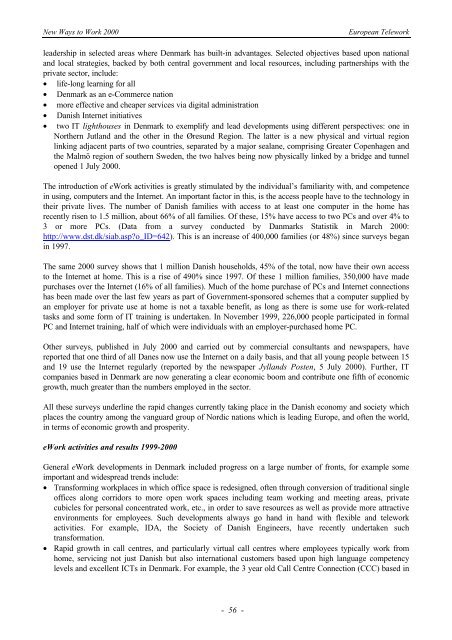eWORK 2000 - European Telework Week
eWORK 2000 - European Telework Week
eWORK 2000 - European Telework Week
- No tags were found...
You also want an ePaper? Increase the reach of your titles
YUMPU automatically turns print PDFs into web optimized ePapers that Google loves.
New Ways to Work <strong>2000</strong><strong>European</strong> <strong>Telework</strong>leadership in selected areas where Denmark has built-in advantages. Selected objectives based upon nationaland local strategies, backed by both central government and local resources, including partnerships with theprivate sector, include:• life-long learning for all• Denmark as an e-Commerce nation• more effective and cheaper services via digital administration• Danish Internet initiatives• two IT lighthouses in Denmark to exemplify and lead developments using different perspectives: one inNorthern Jutland and the other in the Øresund Region. The latter is a new physical and virtual regionlinking adjacent parts of two countries, separated by a major sealane, comprising Greater Copenhagen andthe Malmö region of southern Sweden, the two halves being now physically linked by a bridge and tunnelopened 1 July <strong>2000</strong>.The introduction of eWork activities is greatly stimulated by the individual’s familiarity with, and competencein using, computers and the Internet. An important factor in this, is the access people have to the technology intheir private lives. The number of Danish families with access to at least one computer in the home hasrecently risen to 1.5 million, about 66% of all families. Of these, 15% have access to two PCs and over 4% to3 or more PCs. (Data from a survey conducted by Danmarks Statistik in March <strong>2000</strong>:http://www.dst.dk/siab.asp?o_ID=642). This is an increase of 400,000 families (or 48%) since surveys beganin 1997.The same <strong>2000</strong> survey shows that 1 million Danish households, 45% of the total, now have their own accessto the Internet at home. This is a rise of 490% since 1997. Of these 1 million families, 350,000 have madepurchases over the Internet (16% of all families). Much of the home purchase of PCs and Internet connectionshas been made over the last few years as part of Government-sponsored schemes that a computer supplied byan employer for private use at home is not a taxable benefit, as long as there is some use for work-relatedtasks and some form of IT training is undertaken. In November 1999, 226,000 people participated in formalPC and Internet training, half of which were individuals with an employer-purchased home PC.Other surveys, published in July <strong>2000</strong> and carried out by commercial consultants and newspapers, havereported that one third of all Danes now use the Internet on a daily basis, and that all young people between 15and 19 use the Internet regularly (reported by the newspaper Jyllands Posten, 5 July <strong>2000</strong>). Further, ITcompanies based in Denmark are now generating a clear economic boom and contribute one fifth of economicgrowth, much greater than the numbers employed in the sector.All these surveys underline the rapid changes currently taking place in the Danish economy and society whichplaces the country among the vanguard group of Nordic nations which is leading Europe, and often the world,in terms of economic growth and prosperity.eWork activities and results 1999-<strong>2000</strong>General eWork developments in Denmark included progress on a large number of fronts, for example someimportant and widespread trends include:• Transforming workplaces in which office space is redesigned, often through conversion of traditional singleoffices along corridors to more open work spaces including team working and meeting areas, privatecubicles for personal concentrated work, etc., in order to save resources as well as provide more attractiveenvironments for employees. Such developments always go hand in hand with flexible and teleworkactivities. For example, IDA, the Society of Danish Engineers, have recently undertaken suchtransformation.• Rapid growth in call centres, and particularly virtual call centres where employees typically work fromhome, servicing not just Danish but also international customers based upon high language competencylevels and excellent ICTs in Denmark. For example, the 3 year old Call Centre Connection (CCC) based in- 56 -








